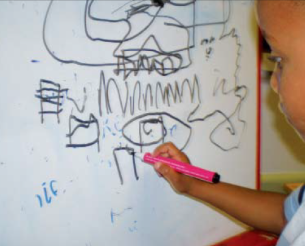

This blog continues from ‘Preparing For Literacy’- A Review – Part 1
Part 2
The guidance outlines the different parts involved in developing effective writers: the mechanics of handwriting (transcription) & the expression of writing (composition).
“Reading and writing focus on the reception and production of meaning respectively, but they share many underlying processes. Furthermore, the two can be mutually reinforcing improving reading can support the development of writing (for instance, learning phonics can be integrated with practising writing letters).” (EEF Guidance page 14)
It then offers ideas on the importance of developing a fluent writing style in order to effectively communicate children’s ideas, thoughts & knowledge.
“Extensive practice is needed to develop effective handwriting,” page 14
Whilst this is of course important, it is also essential to consider what needs to be in place for children to have an effective level of control of their large & small muscles in order that they can then confidently practise the fluency needed in handwriting. Such activities could include:
Gross Motor Skills
Whole arm and shoulder actions developing anti-clockwise and vertical movements
Hand-eye Co-ordination and Fine Motor Skills
In conjunction with these activities, it is also important to introduce the world of letter formation to children (those who are ready for this- ready with the necessary physical skills & also ready with the level of understanding to match the written shape to the name & sound that these shapes represent). Box 5 in the guidance outlines handwriting difficulties citing;
“Handwriting is a complex activity that involves the co-ordination of motor and visual-motor
skills.
Up to 30% of children may experience handwriting difficulties, so it is important to carefully monitor and plan appropriate support and intervention.
Such children are likely to benefit from individualised instruction, but it is important to identify the specific issue before planning further support.
It is also challenging for children to unlearn poor habits, so dealing with handwriting issues early—for example, by ensuring appropriate grip—is likely to be more effective than later intervention.”
Acknowledging the early mark making attempts from children as an important & significant developmental stage in its own right is vital in providing this personalised & targeted approach as mentioned above – not moving to a more formal stage too quickly as this could be detrimental to how the child views writing (motivation) & also trying to use the muscles before they are ready.

Included, with permission, from Mark Making Matters (2008)
What, as the guidance, states could prove useful to improve writing is to build on & enhance the understanding of expressive language skills. There are obvious links here with the spoken language which is how many settings incorporate writing into their literacy sessions. By providing many opportunities which enable children to use their spoken language in conjunction with how this is visually represented (written form) helps the child to strengthen their knowledge of everything to do with a particular letter name, sound, word & sentence. This multi- dimensional approach builds layers in their understanding until they are able to get to the point where they are able to operate all their retrieval strategies based on secure understanding. Crucial to this is to ensure that experiences to write are effective motivators: that is children see a reason to want to record their ideas & thoughts.
This link between spoken language & other areas of literacy can be demonstrated by Stackhouse & Wells (2006) in their description of the speech processing system.
This theory highlights what processes take place to analyse information which is heard. The SPS employs different strategies to recognise, discriminate & accommodate sounds which are then stored. Following this, the SPS employs a series of instructions which incorporate skills of phonological awareness, which then enable sounds to be made through talk and/or can be read or written.
This quite simplistic diagram paradoxically reinforces the intricate processes which are involved in become competent talkers, readers & writers. Specifically in the development of writing skills, an awareness of this process may impact what provision is shared with children but may also help practitioners consider the pace & sequence of how writing skills are either explicitly taught or how provision is further enhanced to reinforce or challenge key skills.
Where I have been able to share this diagram with practitioners, it has certainly generated discussions on the expectations that are placed on children to access a wide variety of skills & have promoted reflections on provision. Providing more opportunities for regular mark making has been a starting point for changes in provision for many of the practitioners; which they have since reported back to say that this enhanced opportunity has encouraged the less reluctant writer to ‘have a go’. It had also led to reviews of specific handwriting policies to ensure that there is a progression of skills & attitudes being planned which developmentally support & challenge all children.